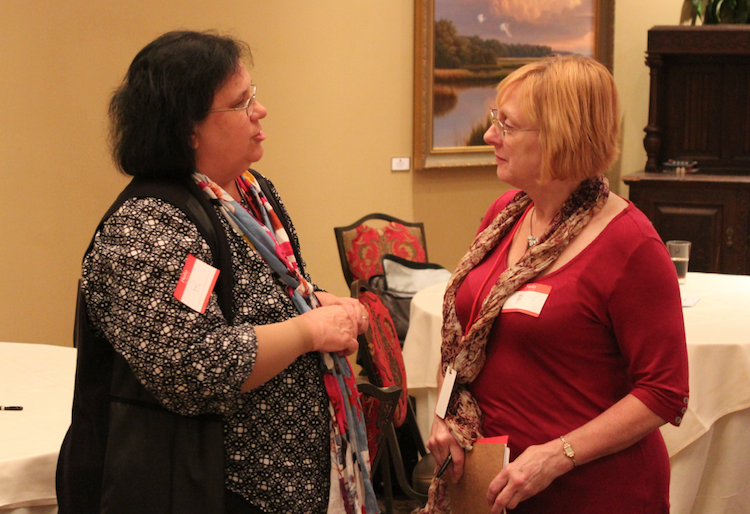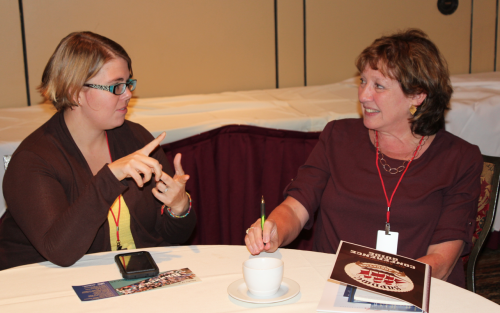
In October of 2015, more than 30 higher-ed in-plant managers met in St. Augustine, Florida, for three days of networking and educational sessions. The 40th annual Southeastern University Printing and Digital Managers Conference (SUPDMC) featured sessions on quality management, workflow, envelope printing, leadership and more. Attendees came from all over the southern U.S. as well as from Delaware, Pennsylvania, Ohio and California.
More than a dozen suppliers showed their wares and talked with attendees during a two-day vendor fair. Managers also got to tour Mac Papers' local envelope converting facility on the last day of the event.
The conference kicked off with a 90-minute presentation by Gary Jones, assistant VP of Printing Industries of America, in which he sought to dispel some of the often-cited myths about printing (i.e., it kills trees, it’s less effective than digital communication, etc.). He presented data showing how print is much more sustainable and renewable than the digital technologies seeking to displace it.
For example, the U.S. forest product industry plants more than four million trees a day, he said—more than the number that it harvests. Reading printed material yields higher data retention rates than reading from screens, he pointed out, and direct mail brings higher response rates than email campaigns. In fact, recipients are 37 times more likely to respond to a direct mail piece than an email, he pointed out.
- Chapters
- descriptions off, selected
- captions settings, opens captions settings dialog
- captions off, selected
This is a modal window.
The Video Cloud video was not found.
Beginning of dialog window. Escape will cancel and close the window.
End of dialog window.
This is a modal window. This modal can be closed by pressing the Escape key or activating the close button.
This is a modal window. This modal can be closed by pressing the Escape key or activating the close button.
Penn State's Abbas Badani, director of PSU's Multimedia & Print Center, impressed the crowd with a demonstration of the print portal he created to manage print outsourcing. All vendors must bid electronically through the portal. Jobs are awarded based on which vendor offers the best value. Because the in-plant has the opportunity to see all the work, he said, it can position itself to deliver value where it can be most effective.

Penny Bellard, of the University of Arkansas, talks with Sally Roberts, from the University of West Georgia.
To keep bids on a more level playing field, the in-plant provides all the paper for each job. SUPDMC attendees expressed surprise that the in-plant does not mark up paper costs through an administrative fee, but Badani insisted that this has given his in-plant more credibility, showing departments that the shop is not out to make a profit but wants to truly get them the best deal. Because of the print portal, vendors can't complain to the university that they aren't getting enough business, Badani said, because that is now entirely up to them.
One memorable session focused on leadership styles. Dr. Bill Faulkner split the group into four categories based on various traits. Some valued careful attention to details, while others were better at social interaction. The categories into which managers were sorted continued to be referenced throughout the conference.
Value-added Services
A panel discussion on best practices inspired a room-wide discussion of wide-format printing, with managers sharing ideas for successful applications. Many have gotten a lot of business producing yard signs, which are stuck into the ground around campus to promote student activites, sporting events and other occasions. Several talk about the benefits of printing displays on fabric instead of paper, so they can be more easily folded up and transported by traveling faculty. Canvas wraps are another burgeoning business, as are buttons, bus window wraps and magnets.
Also discussed at that session was the question of what managers are doing to prepare their in-plants to survive after their retirement. The next generation of leaders must be trained, given more responsibilities and introduced to the administration officials that the manager now works with.
Steve Barrett, of the University of North Carolina-Wilmington, gave a presentation showing the many new services his in-plant has started offering since adopting a "we can do that" attitude. The in-plant rents out space on light poles and prints signage to hang there for groups promoting their events. His staff is in charge of hanging the signage.
The shop also makes its own frames out of two-by-fours that Barrett purchases for producing gallery wraps.
"Admissions loves them," he said. "It's a great money maker." (Read IPG's June story on this in-plant.)
Workflow Benefits
Other speakers at SUPDMC include Debbie Pavletich, of Ricoh Americas, who discussed how workflow software can bring cost savings and increase productivity. She explained how MIS, Web-to-print, variable data and color management software can help printers minimize error, improve quality and provide faster turnaround times by reducing touch points and standardizing processes.

Sarah Gregory, of Eastern Kentucky University, talks with Jo Ann Fincken, of Northern Kentucky University.
"If you don't have a Web-to-print storefront, you really do need to have one," she advised attendees, saying it is becoming the norm at in-plants.
Pavletich, who formerly managed Briggs & Stratton's in-plant, detailed the time savings that the shop's print MIS brought to such tasks as creating job estimates, scheduling and tracking jobs, tracking labor and developing reports.
"Having a print MIS system, it's going to take you 50 percent less time" to accomplish these tasks, she said.
Related story: Successful Southern Conference

Bob has served as editor of In-plant Impressions since October of 1994. Prior to that he served for three years as managing editor of Printing Impressions, a commercial printing publication. Mr. Neubauer is very active in the U.S. in-plant industry. He attends all the major in-plant conferences and has visited more than 180 in-plant operations around the world. He has given presentations to numerous in-plant groups in the U.S., Canada and Australia, including the Association of College and University Printers and the In-plant Printing and Mailing Association. He also coordinates the annual In-Print contest, co-sponsored by IPMA and In-plant Impressions.












